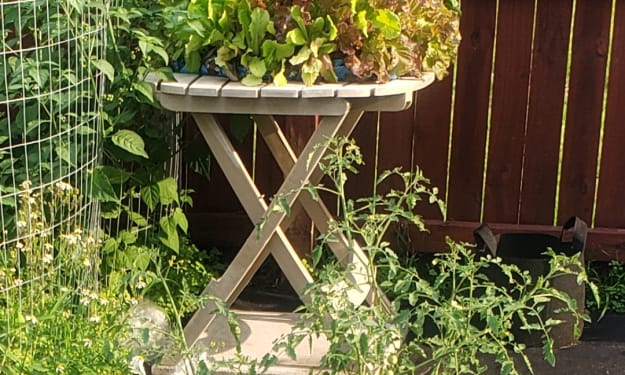My 5 Best Tips For Growing Radishes and Kholrabi
Tips to growing your own food no matter how small a space you have!

I really do not have a lot to share as far as root veggies go, I am as I said before, still learning and using this as a tool to get the information out there as I learn it. I garden in a small urban home and am trying to find the best ways to maximize my production in the least amount of space possible. Everything that I chose for the original article “Growing Your Own Food”, I have tested growing in pots as well as in ground to make sure that even someone in an apartment would have access to growing these. Of course even in an apartment some things will be harder even in pots since not all apartments have porches. You may have to utilize table space up against a window that gets the most light in your apartment. I did notice less light does cause the plants to produce a bit slower, but I also noticed that even with less light, while producing slower, they still produced food. Once you start to grow your own food, you will pick up tricks that work the best for your individual situation. The most important part of it all is that you try, even if you failed in the past try again. For this article I am going to group both radishes and kohlrabi from the original article that I promised these tips from, “Growing Your Own Food”. If you have not read that one yet, I would recommend you read it so you can follow along with the tips and the outline I am giving for how I have had the success that I have had growing as much food as I have. It will also be much appreciated if you did! So here are, in my experience, what I found to be the 5 most important things when growing radishes and kohlrabi (and quite frankly with any root vegetables like carrots, onions etc. etc, but not potatoes- those have some different rules all on their own and I highly suggest doing full research on potatoes before growing on your own as they can be poisonous if done incorrectly or harvested too early or too late).
1. Start your seeds where you plan to harvest them. I have heard of many people starting kohlrabi or radishes indoors and then transplanting them into the garden, but I have never had success with that. Every time I tried to transplant them as seedlings, I never successfully received a harvest from them. They would either not survive the move or they survived but always gave me an inedible small resemblance of a kohlrabi or radish. So, in an effort to give my tips on how I was able to produce enough food out of my garden, I am keeping these tips to what I have experienced as the best way to receive the most food with the least amount of errors. Getting started in the garden is the most expensive part of it all, so I want to use this as a platform to help others not have to spend more money than necessary by avoiding mistakes I have made.
2. Start multiple seeds assuming some will not germinate. I always start my radish and kohlrabi seeds closer than what is recommended on the package because I want to ensure that I definitely get to harvest in the next couple of weeks. When they germinate and begin to grow and show no signs of issues I then choose to thin them out to proper spacing and either find another spot for them-knowing I may not yield anything from them, or I eat them as micro-greens. Most of the time when I move them to a different location they end up bolting and going to seed before they ever form a root vegetable worthy to harvest. This seems true even when they're moved to a shaded area, a couple of times I even did get to harvest food from the transplants- but that's pretty rare.
3. It is important to remember when sowing these types of vegetables, that each seed provides 1 vegetable to harvest. I always make sure to set one or two aside that are intentional to not harvest so I can allow them to bolt, go to flower and then go to seed. With kohlrabi and radishes they put off cute little white flowers with these little baby pods that look like teeny tiny pea pods when they bolt. These little pods are what holds the plant's seeds. Once those pods begin to dry out on the plant you can pull them off and harvest the seeds out of them to plant more! I typically do this by letting the transplants I moved when thinning out go to seed. So while it feels like you may have just wasted 1 vegetable you could have harvested by moving this little transplant knowing it may never give you anything to harvest, it instead will give you (in my experience) 25 to up to 100 seeds to plant.
4. Another thing I learned with radishes and kohlrabi is they definitely do not appreciate it if you over fertilize them. If their nitrogen content gets too high they will bolt faster than they are able to form their vegetable for you to eat. Once they bolt, the plant believes its work here is complete and when it releases its seed, it will die off.
5. This tip works great for small spaces but for radishes only since kohlrabi does get rather large. I like to plant my radishes in pots or spots that are for other plants, they grow really fast and do not take up much room and will be harvested before the other plant has grown large enough to need all of its space. You can also juice the leaves of it if they begin to block sunlight for your other plants. As long as you leave some leaves for the plant to be able to photosynthesize you will not harm the plant. I just take the largest leaves off and juice them. They have a spicier flavor than most greens have, very similar to the taste of a mustard green.
These are what I found to be the 5 most important tips when growing radishes and kohlrabi. They are also great tips for any root vegetables where you get 1 vegetable per seed essentially, so for things like potatoes, some of these tips may be helpful but with potatoes it is very important to do your research before hand. I want to thank you for taking time out of your day to read my article. I truly hope you enjoyed it and got some useful information out of it. It is one of the articles that stems from the article “Growing Your Own Food” where I give a list of the 11 plants I found were the best combination to growing a variety of food that was plentiful enough to make sustainable meals with. If you want to read that article you can find it by clicking on my name at the top of this article, it will take you to a page with both that article along with other articles that are written by me, it also would certainly be appreciated if you read those as well! I would be more than happy to answer any of your questions if you want to reach out to me on Instagram or Twitter @Garden4Solace. I will also be sharing some tips and photos periodically so please head on over there and give me a follow and say hello! I am by no means a garden pro, so I would love it if you would share your suggestions with me as well! If you are reading this article on Vocal and enjoyed it, consider leaving a tip to help support my urban farm! Wishing you a happy, healthy and wonderfully abundant gardening year






Comments
There are no comments for this story
Be the first to respond and start the conversation.